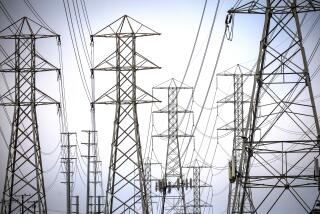A PG&E; Tale That Refuses to Wind Down
It may be of little general interest, but I feel obliged to report that many readers have verified Prof. Donald Ward’s recollection that in 1948 a hydroelectric power shortage in Northern California caused the Pacific Gas & Electric Co. to drop its frequency from 60 to 59 cycles, thus causing electric clocks to lose one minute every hour.
You may recall that David Simmons of Ridgecrest said he doubted that PG&E; met its shortage by lowering its frequency. He argued that the utility could probably not have controlled its frequency, and that, in any case, lowering it might have increased the need for power.
Bill Myers, historian for the Southern California Edison Co., said that PG&E; would not consciously have lowered its frequency, but that it might have “shaved the voltage” to save power, one result being a drop in frequency. He recalled that PG&E; did have a shortage in 1948, and he thought a drop in frequency was entirely possible.
Ron Rutkowski, a spokesman for PG&E;, said the company had no records of such an event and no present employees remembered it. He added that, in any case, lowering the frequency would have damaged the machinery.
Noting that Ward is a professor of Germanic languages and folklore at UCLA, I concluded: “Is it history. Or is it folklore?”
“In 1948,” writes Robert W. Otto of Moreno Valley, “I was a disc jockey, engineer, announcer, news reader and janitor at radio station KPRL in Paso Robles. Although after 40 years the memory is fading, I have a definite recollection of the change in PG&E; power line frequency. The old clock on the studio wall just wasn’t keeping time.”
“Prof. Ward is correct about the less than 60 cycles,” writes N. B. Weisenberger of Garden Grove. “He is also right about the drought. PG&E; was saving water, not cycles. A reduced flow turned the turbines more slowly and helplessly the clocks followed suit.”
Weisenberger said that Simmons and Rutkowski should have been aware of the tolerance of electric motors for cycle variance. “Most motors of the era (except for clocks) were rated 50/60 cycles and didn’t really care what time it was.”
“I was at Stanford at that time,” recalls Edward F. Garcia, “and I remember distinctly that it happened just as stated (by Prof. Ward.) All electric clocks ran slow. I remember one professor who, evidently finding us dull that morning, remarked, ‘Apparently, it’s not only the clocks that are running slow today.”’
“They did indeed cut the power frequency during this period,” says Ernest L. Lusk of La Verne, who was at that time employed by Edison in the Porterville office. “Most of my time in the office was spent trying to explain why the clocks were all showing the wrong time.”
Robert Gottleib was studying electrical engineering at Cal Poly San Luis Obispo in 1948 and says, “I remember coming in for class in the morning and all the clocks in the school were running slow. I was told that due to a water shortage PG&E; had dropped the frequency to 59 cycles.”
“At that time,” recalls R. R. Gates of Fullerton, “a fellow graduate student at Stanford University, John R. Mosley, was working on his doctorate in chemistry. Part of his experimental work required accurate timing, for which he relied on the constant frequency of the power source. I recall his commenting that he needed to adjust his calculations to allow for the frequency reduction, which occurred during some of his experiments.”
If you want to check that out, Gates suggests, you might find it among the footnotes in Dr. Mosley’s dissertation: “Thermodynamic Data for Some Cyclic Organic Compounds Containing Oxygen,” by J. R. Mosley, 1948.
K. R. Jewett of Marina del Rey was working as a utility man for PG&E; at a Pitt River powerhouse near Fall River Mills. He recalls that the winter of 1947-48 was stormy. Boulder Dam went off the line; Los Angeles was drawing on PG&E; power and Pitt River was ordered to meet the demand.
“Way back in ‘48, as in ‘88, just about anything was possible,” Jewett says. “It’s just that in the frequency of retelling the story, it eventually becomes folklore.”
I knew that sooner or later Los Angeles would be blamed.
More to Read
Sign up for Essential California
The most important California stories and recommendations in your inbox every morning.
You may occasionally receive promotional content from the Los Angeles Times.










